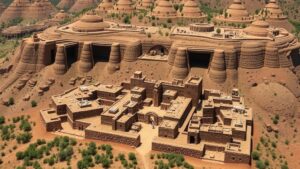Following forgotten Aztec treasure trails leading to rumored gold caches.
Following Forgotten Aztec Treasure Trails Leading to Rumored Gold Caches
The world continues to be fascinated by the legendary treasures of the Aztec Empire, an ancient civilization that thrived in modern-day Mexico until the Spanish conquest in the early 16th century. Rumored to be buried in various locations across the country, these caches of gold, jewels, and artifacts have sparked countless treasure hunts, revealing both the allure of adventure and the rich history of the Aztecs. This article explores the forgotten trails leading to these rumored treasures, providing a glimpse into the past while addressing the challenges and realities of treasure hunting.
The Aztec Empire: A Brief Overview
The Aztecs, who established their empire around the 14th century, were known for their advanced knowledge in various fields such as agriculture, architecture, and astronomy. At its height, the empire included around 5 to 6 million people. The Aztec capital, Tenochtitlan–now modern-day Mexico City–was renowned for its wealth, characterized by gold artifacts, intricate jewelry, and lavish temples.
Following the arrival of Spanish conquistadors led by Hernán Cortés in 1519, the empire faced severe exploitation. Recognizing the immense wealth, Cortés sought to extract as much treasure as possible, with reports indicating that he amassed mountains of gold. But, much of this treasure was either melted down or hidden in response to the conquest and subsequent colonization.
Legendary Treasure Trails
Many legends of Aztec treasure trails have emerged over the centuries, often blending fact with folklore. Some of the most noted trails include:
- The Lost Treasure of Montezuma: The last Aztec emperor, Moctezuma II, is rumored to have hidden vast sums of gold in the mountains surrounding Tenochtitlan as Spanish forces advanced. Many believe his treasures lie somewhere in the Sierra Nevada mountains.
- The Treasure of the Tlaxcalans: Following their alliance with the Spanish against the Aztecs, it is rumored that the Tlaxcalans hid their own treasures in concealed locations near their homeland, now in the state of Tlaxcala.
- La Ciudad Perdida (The Lost City): Various explorers have sought the whereabouts of an alleged hidden city that holds treasures from the Aztec civilization. This lost city is believed to be located in the dense jungles of Southern Mexico.
Challenges of Treasure Hunting
While the prospect of finding long-lost treasures is exhilarating, treasure hunting comes with significant challenges. Knowledge of the area, local laws, and environmental conditions play crucial roles in the effectiveness of a treasure hunt.
For example, Mexican laws are incredibly strict regarding artifact recovery. According to the Mexican Federal Law on Archaeological, Artistic, and Historic Monuments and Zones, all archaeological finds belong to the nation. This means treasure hunters could face legal ramifications if they uncover artifacts. Plus, the dense and often dangerous terrains add to the complexities of treasure hunting.
Modern-Day Treasure Hunters
Despite the challenges, numerous modern-day treasure hunters and organizations continue to seek the great lost wealth of the Aztecs. Many utilize advanced technology, such as ground penetrating radar (GPR) and metal detectors, to increase their chances of success. Others rely on historical maps and indigenous knowledge to uncover hidden trails.
For example, in 1970, amateur archaeologist Reginald P. A. de la Ossa led an expedition in the hills near Oaxaca, claiming to have found signs of ancient treasure encampments and potential gold caches. His findings, however, were later deemed inconclusive due to insufficient evidence.
Real-World Applications and The Quest for Knowledge
The allure of Aztec treasures has inspired not just treasure hunters but also historians and archaeologists to delve deeper into the ancient civilizations wealth, trade practices, and cultural significance. Academic research into these lost treasures can contribute to our understanding of indigenous cultures and the impacts of European colonization.
Ultimately, the paths of pursuit lead treasure hunters on a deeper journey into history, culture, and identity, fueled by the hope of uncovering not just gold but stories of resilience and adaptation from a fallen empire.
Actionable Takeaways
- Research local laws and regulations before undertaking any treasure hunting expedition in Mexico.
- Use modern technology to enhance your treasure hunting efforts while being respectful of historical significance.
- Consider engaging with local communities and historians to develop a richer understanding of the area and its history.
Following the forgotten Aztec treasure trails is more than an adventure; it’s a journey that intertwines modern exploration with ancient history, offering lessons about culture, heritage, and the complex legacy of the Aztec Empire.



